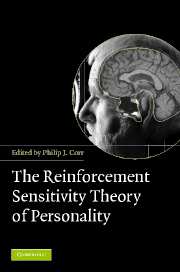Book contents
- Frontmatter
- Contents
- List of abbreviations
- List of figures
- List of tables
- List of contributors
- Preface
- 1 Reinforcement Sensitivity Theory (RST): introduction
- 2 The neuropsychology of fear and anxiety: a foundation for Reinforcement Sensitivity Theory
- 3 Animal cognition and human personality
- 4 The behavioural activation system: challenges and opportunities
- 5 Reinforcement Sensitivity Theory and personality
- 6 Reinforcement sensitivity scales
- 7 Performance and conditioning studies
- 8 Psychophysiological studies
- 9 Reinforcement Sensitivity Theory and mood induction studies
- 10 Neuro-imaging and genetics
- 11 Reinforcement Sensitivity Theory and psychosomatic medicine
- 12 RST and clinical disorders: anxiety and depression
- 13 RST and psychopathy: associations between psychopathy and the behavioral activation and inhibition systems
- 14 Behavioural activation and inhibition in social adjustment
- 15 Reinforcement sensitivity in the workplace: BIS/BAS in business
- 16 Formal and computational models of Reinforcement Sensitivity Theory
- 17 Reinforcement Sensitivity Theory: a critique from cognitive science
- 18 The contribution of Reinforcement Sensitivity Theory to personality theory
- General Index
- Index of Names
- References
6 - Reinforcement sensitivity scales
Published online by Cambridge University Press: 31 January 2011
- Frontmatter
- Contents
- List of abbreviations
- List of figures
- List of tables
- List of contributors
- Preface
- 1 Reinforcement Sensitivity Theory (RST): introduction
- 2 The neuropsychology of fear and anxiety: a foundation for Reinforcement Sensitivity Theory
- 3 Animal cognition and human personality
- 4 The behavioural activation system: challenges and opportunities
- 5 Reinforcement Sensitivity Theory and personality
- 6 Reinforcement sensitivity scales
- 7 Performance and conditioning studies
- 8 Psychophysiological studies
- 9 Reinforcement Sensitivity Theory and mood induction studies
- 10 Neuro-imaging and genetics
- 11 Reinforcement Sensitivity Theory and psychosomatic medicine
- 12 RST and clinical disorders: anxiety and depression
- 13 RST and psychopathy: associations between psychopathy and the behavioral activation and inhibition systems
- 14 Behavioural activation and inhibition in social adjustment
- 15 Reinforcement sensitivity in the workplace: BIS/BAS in business
- 16 Formal and computational models of Reinforcement Sensitivity Theory
- 17 Reinforcement Sensitivity Theory: a critique from cognitive science
- 18 The contribution of Reinforcement Sensitivity Theory to personality theory
- General Index
- Index of Names
- References
Summary
Gray's (1970, 1981, 1982) personality theory, currently referred to as the Reinforcement Sensitivity Theory (RST) (Pickering, Díaz and Gray 1995) has defined the existence of three conceptual nervous systems that underlie three orthogonal personality dimensions. These systems reflect brain structures that influence sensitivity to reinforcing events and control the experience of emotion. The best known is the Behavioural Inhibition System (BIS); this system normally functions as a comparator, taking control of behaviour in response to signals of punishment, frustrative non-reward and novel stimuli. In terms of individual differences in personality, the BIS is related to the trait-anxiety dimension. As regards its relationship with Eysenckian dimensions, the BIS runs from the neurotic introvert quadrant (maximum BIS activity) to the stable extravert quadrant (minimum BIS activity). The second system is called the Behavioural Approach System (BAS) and is considered independent of the BIS; this system is responsible for approach behaviour in response to incentives (signals of reward or non-punishment). Individual differences in the functioning of the BAS are related to the impulsivity dimension of personality. This dimension is orthogonal to anxiety, and runs from stable introvert (minimum BAS activity) to neurotic extravert (maximum BAS activity) quadrants. The third system, the Fight-Flight System (FFS) is the most recently proposed of the three (Gray 1987a) and is the least clearly defined. It is activated by the presence of unconditioned aversive stimuli promoting fight or escape behaviour.
- Type
- Chapter
- Information
- The Reinforcement Sensitivity Theory of Personality , pp. 188 - 227Publisher: Cambridge University PressPrint publication year: 2008
References
- 21
- Cited by

